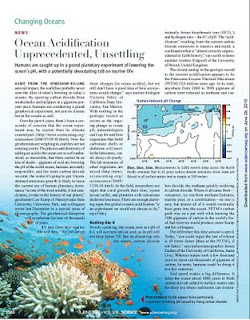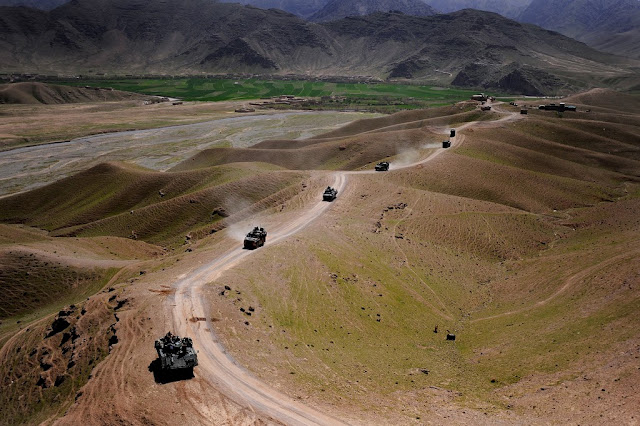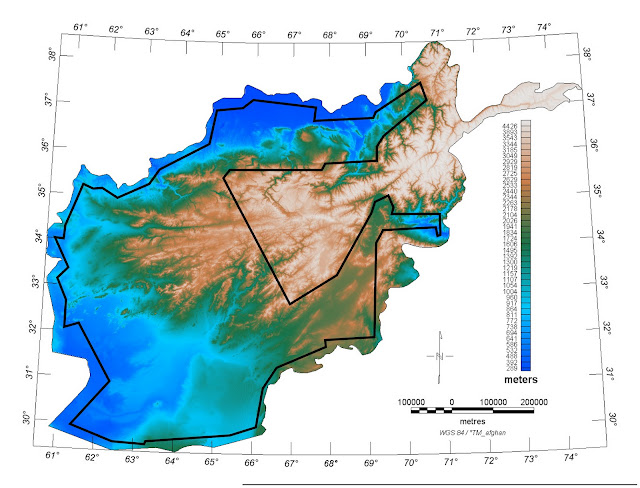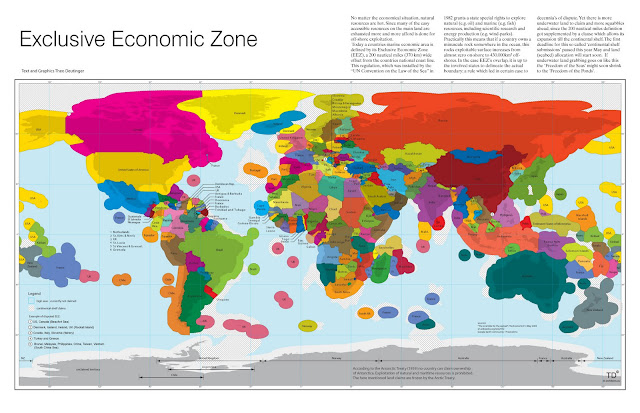-
India’s Maoists: South Asia’s “Other” Insurgency
›July 7, 2010 // By Schuyler Null
The Indian government’s battle with Maoist and tribal rebels – which affects 22 of India’s 35 states and territories, according to Foreign Policy and in 2009 killed more people than any year since 1971 – has been largely ignored in the West. That should change, as South Asia’s “other” insurgency, fomenting in the world’s largest democracy and a key U.S. partner, offers valuable lessons about the role of resource management and stable development in preventing conflict.
-
Rough Waters Ahead: Our Changing Ocean
›From the ocean-themed June issue of Science comes “Sea-Level Rise and Its Impact on Coastal Zones“, by Robert J. Nicholls and Anny Cazenave. While sea-level rise will “almost certainly accelerate through the 21st century and beyond because of global warming,” Nicholls and Cazenave state that its magnitude remains uncertain. Small islands as well as the coasts of Africa, India, Southeast Asia, and China are identified as vulnerable areas because of their “dense populations, low elevations, appreciable rates of subsidence, and/or inadequate adaptive capacity.” Nicholls and Cazenave call for more research and analysis into adaptation, which “remains a major uncertainty.” “Ocean Acidification: Unprecedented, Unsettling,” by Richard A. Kerr, also appears in the June issue of Science. “Humans are caught up in a grand planetary experiment of lowering the ocean’s pH, with a potentially devastating toll on marine life,” begins Kerr, who aims to convince climate change-focused readers to also look at the world’s oceans. Rising pH levels, caused by ocean waters absorbing higher levels of carbon dioxide, are damaging shelled creatures, coral, and the organisms that rely on them for sustenance (which includes people, especially coastal populations dependent on the oceans for protein). An Australian survey recently found that calcification in the Great Barrier Reef had declined 14.2 percent since 1990 – a severe decline that has not been matched in the last 400 years. Kerr claims that “aside from the dinosaur-killing asteroid impact, the world has probably never seen the likes of what’s brewing in today’s oceans.”
“Ocean Acidification: Unprecedented, Unsettling,” by Richard A. Kerr, also appears in the June issue of Science. “Humans are caught up in a grand planetary experiment of lowering the ocean’s pH, with a potentially devastating toll on marine life,” begins Kerr, who aims to convince climate change-focused readers to also look at the world’s oceans. Rising pH levels, caused by ocean waters absorbing higher levels of carbon dioxide, are damaging shelled creatures, coral, and the organisms that rely on them for sustenance (which includes people, especially coastal populations dependent on the oceans for protein). An Australian survey recently found that calcification in the Great Barrier Reef had declined 14.2 percent since 1990 – a severe decline that has not been matched in the last 400 years. Kerr claims that “aside from the dinosaur-killing asteroid impact, the world has probably never seen the likes of what’s brewing in today’s oceans.” -
U.S. Navy Task Force on Implications of Climate Change
›What about climate change will impact us? That’s the question the Navy’s Task Force Climate Change is trying to answer. Rear Admiral David Titley explains the task force’s objectives in this interview by the American Geophysical Union (AGU) at their recent “Climate Change and National Security” event on the Hill.
The task force is part of the military’s recent efforts to try to better understand what climate change will mean for the armed forces, from rising sea levels and ocean acidification to changing precipitation patterns. In the interview, Admiral Titley points out that for the Navy in particular, it is important to understand and anticipate what changes may occur since so many affect the maritime environment.
The Navy’s biggest near-term concern is the Arctic, where Admiral Titley says they expect to face significant periods of almost completely open ocean during the next two to three decades. “That has huge implications,” says Titley, “since as we all know the Arctic is in fact an ocean and we are the United States Navy. So that will be an ocean that we will be called upon to be present in that right now we’re not.”
Longer term, the admiral points to resource scarcity and access issues and sea level rise (potentially 1-2 meters) as the most important contributing factors to instability, particularly in places like Asia, where even small changes can have huge impacts on the stability of certain countries. The sum of these parts plus population growth, an intersection we examine here at The New Security Beat, is something that deserves more attention, according to Titley. “The combination of climate, water, demographics, natural resources – the interplay of all those – I think needs to be looked at,” he says.
Check out the AGU site for more information, including an interview with Jeffrey Mazo – whose book Climate Conflict we recently reviewed – discussing climate change winners and losers and the developing world (hint: the developing world are the losers).
Sources: American Geophysical Union, New York Times.
Video Credit: “What does Climate Change mean for the US Navy?” courtesy of YouTube user AGUvideos. -
Interview With Wilson Center Scholar Jill Shankleman: Could Transparency Initiatives Mitigate the Resource Curse in Afghanistan?
›June 25, 2010 // By Schuyler Null
In the wake of The New York Times article detailing a potential mineral bonanza in Afghanistan, Senators Ben Cardin and Dick Lugar earlier this week published an op-ed in support of a bill that would create “an international standard for transparency in law” by requiring oil, gas, and mining industries to report amounts paid for drilling/mining rights in their SEC filings. A similar program, albeit a voluntary one, already exists – the Extractive Industries Transparency Initiative (EITI). The senators, however, raised questions about the ability of EITI to ensure transparency and accountability of payments for future mining rights to Afghanistan’s government. Joining EITI was a “good first step,” they say, “but too many countries and companies remain outside this system.”
-
Brookings’ “Taking Stock of the Youth Challenge in the Middle East”
›Samantha Constant and Mary Kraetsch of the Brookings Institution have created a handy visual aid to understanding the Middle East’s demographics. The interactive flash graphic shows select economic and demographic information as you scroll over each country, including GDP per capita, youth percentage of the population, secondary school enrollment rate, and unemployment figures. Clicking on each country brings up a more detailed fact sheet that breaks down economic, education, and demographic statistics.
The companion write-up to the map stresses the importance of these figures to youth-inclusive development. Citing the 2009 UN Arab Human Development Report, the authors point out that the region will need to create about 51 million jobs by 2020 to account for youth entering the work force and already high unemployment rates.
The report does however shy away from some of the Middle East’s most difficult demographic challenges. Iraq and the West Bank are mentioned as areas that will continue to have large youth bulges, but Yemen, which has far and away the most troubling demographics in the region, is not mentioned at all. Adding “total fertility rate” as a statistic, which shows the average number of children born to an average woman over her lifetime, might illustrate these trouble areas more clearly. As illustrated by data from the Population Reference Bureau, Yemen (5.5), the Palestinian Territory (4.6), and Iraq (4.4) all have noticeably higher total fertility rates than other countries in the region, which helps explain why their demographic problems will continue.
The inclusion of total fertility rates would also help make a stronger argument for closer attention to be paid to women’s rights issues, as generally better women’s rights translates to lower total fertility rates, which help draw down youth bulges over time. The report only briefly mentions that more research is needed to create better paths for young women to become productive members of society with “greater career opportunities beyond traditional roles.”
The map does mention that information will be updated on a regular basis so it is worth checking back to see what it added to this useful primer.
Sources: The Brookings Institution, Population Reference Bureau.
Interactive Map: “Understanding the Generation in Waiting” courtesy of The Brookings Institution. -
Afghanistan’s Mineral Wealth: Gold Mine, Curse, or Illusion?
›June 15, 2010 // By Schuyler NullAccording to The New York Times, U.S. officials have discovered a veritable bonanza of heavy metals and rare earth minerals in Afghanistan that have the potential “to fundamentally alter the Afghan economy and perhaps the Afghan war itself”:The previously unknown deposits — including huge veins of iron, copper, cobalt, gold and critical industrial metals like lithium — are so big and include so many minerals that are essential to modern industry that Afghanistan could eventually be transformed into one of the most important mining centers in the world, the United States officials believe.
Reaction to the announcement has been mixed, with both Foreign Policy and Wired bloggers expressing skepticism about the timing of the announcement – in the midst of a difficult period of the war – and pointing out that the “discovery” is old news.
Others have expressed hope that the find, worth an estimated $1 trillion, might provide an injection of much-needed capital into one of the world’s worst economies. Environmental security expert Saleem Ali of the University of Vermont told Public Radio International’s The World that “there’s an opportunity now for the country to develop outside of a predominantly drug-dependent economy and if properly managed the minerals could provide a catalyst for all kinds of other activities as well.”
Afghanistan’s rare earth minerals in particular might prove to be extremely valuable as global demand continues to grow for these critical components of renewable energy technology and advanced electronics. The New York Times reports that an internal Pentagon memo says Afghanistan has the potential to become the “Saudi Arabia of lithium”:Just this month, American geologists working with the Pentagon team have been conducting ground surveys on dry salt lakes in western Afghanistan where they believe there are large deposits of lithium. Pentagon officials said that their initial analysis at one location in Ghazni Province showed the potential for lithium deposits as large of those of Bolivia, which now has the world’s largest known lithium reserves.
The existence of mineral reserves in Afghanistan is not new news, nor is foreign interest in them (see our coverage of Chinese copper investments at Aynak earlier this year). But the size of these resources warrants attention and raises new questions about the possibility of the unstable country falling victim to the natural resource curse – remaining mired in poverty while generating billions of dollars for an elite few.
Mineral wealth has a long history of fueling conflict in unstable countries, such as Sierra Leone, Nigeria, and the Democratic Republic of Congo. The DRC’s mining laws – which, like Afghanistan’s, were designed by the World Bank – have not prevented violent struggle to control the country’s valuable resources, as described by John Katunga in ECSP Report 12.
How can Afghanistan’s newly discovered mineral resources be developed without funding insurgents or fueling new conflicts? USAID’s Minerals and Conflict Toolkit offers a start with a set of recommendations and discrete steps that development agencies should take to avoid exacerbating the links between mining, valuable resources, and violent conflict.
Stay tuned for more analysis on Afghanistan’s development, resource curse dynamics, and what this all means for the continuing conflict.
Sources: Foreign Policy, National Public Radio, The New York Times, Public Radio International, Wired.
Photo Credit: “Remote Sensing Survey 2006” courtesy of the U.S. Geological Survey. -
Natural Resource Frontiers at Sea
›As burgeoning populations and growing economies strain natural resource stocks around the world, countries have begun looking to more remote and difficult-to-access resources, including deep-sea oil, gas, and minerals. The UN Convention on the Law of the Sea (UNCLOS) guarantees exclusive access to these resources within 200 nautical miles of a nation’s sovereign territory – called an exclusive economic zone (EEZ). TD Architects’ “Exclusive Economic Zone” illustrates this invisible global chessboard and highlights some examples of disputed areas, such as the South China Sea, the Mediterranean, the Falkland/Malvina Islands, and the Arctic.
-
New Security Challenges in Obama’s Grand Strategy
›June 4, 2010 // By Schuyler NullPresident Obama’s National Security Strategy (NSS), released last week, reinforces a commitment to the whole of government approach to defense, and highlights the diffuse challenges facing the United States, including international terrorism, globalization, and economic upheaval.
Following the lead of the Quadrennial Defense Review released earlier this year, the NSS for the first time since the Clinton years prominently features non-traditional security concerns such as climate change, population growth, food security, and resource management:Climate change and pandemic disease threaten the security of regions and the health and safety of the American people. Failing states breed conflict and endanger regional and global security… The convergence of wealth and living standards among developed and emerging economies holds out the promise of more balanced global growth, but dramatic inequality persists within and among nations. Profound cultural and demographic tensions, rising demand for resources, and rapid urbanization could reshape single countries and entire regions.
By acknowledging the myriad causes of instability along with more “hard” security issues such as insurgency and nuclear weapons, Obama’s national security strategy takes into account the “soft” problems facing critical yet troubled states – such as Pakistan, India, Afghanistan, and Somalia – which include demographic imbalances, food insecurity, and environmental degradation.
Not surprisingly, Afghanistan in particular is highlighted as an area where soft power could strengthen American security interests. According to the strategy, agricultural development and a commitment to women’s rights “can make an immediate and enduring impact in the lives of the Afghan people” and will help lead to a “strong, stable, and prosperous Afghanistan.”
The unique demographic landscape of the Middle East, which outside of Africa has the fastest growing populations in the world, is also given intentional consideration. “We have a strategic interest in ensuring that the social and economic needs and political rights of people in this region, who represent one of the world’s youngest populations, are met,” the strategy states.
Some critics of that strategy warn that the term “national security” may grow to encompass so much it becomes meaningless. But others argue the administration’s thinking is simply a more nuanced approach that acknowledges the complexity of today’s security challenges.
In a speech on the strategy, Secretary of State Clinton said that one of the administration’s goals was “to begin to make the case that defense, diplomacy, and development were not separate entities either in substance or process, but that indeed they had to be viewed as part of an integrated whole and that the whole of government then had to be enlisted in their pursuit.”
Compare this approach to President Bush’s 2006 National Security Strategy, which began with the simple statement, “America is at war” and focused very directly on terrorism, democracy building, and unilateralism.
Other comparisons are also instructive. The Bush NSS mentions “food” only once (in connection with the administration’s “Initiative to End Hunger in Africa”) and does not mention population, demography, agriculture, or climate change at all. In contrast, the 2010 NSS mentions food nine times, population and demography eight times, agriculture three times, and climate change 23 times – even more than “intelligence,” which is mentioned only 18 times.
For demographers, development specialists, and environmental conflict specialists, the inclusion of “new security” challenges in the National Security Strategy, which had been largely ignored during the Bush era, is a boon – an encouraging sign that soft power may return to prominence in American foreign policy.
The forthcoming first-ever Quadrennial Diplomacy and Development Review by the State Department will help flesh out the strategic framework laid out by the NSS. It is expected to provide more concrete policy for integrating defense, diplomacy, and development. Current on-the-ground examples like USDA embedding in Afghanistan, stepped-up development aid to Pakistan, and the roll-out of the administration’s food security initiative, “Feed the Future,” are encouraging signs that the NSS may already be more than just rhetoric.
Update: The Bush 91′ and 92’ NSS also included environmental considerations, in part due to the influence of then Director of Central Intelligence, Robert Gates.
Sources: Center for Global Development, CNAS, Los Angeles Times, State Department, USAID, White House, World Politics Review.
Photo Credit: “Human, Food, and Demographic Security” collage by Schuyler Null from “Children stop tending to the crop to watch the patrol” courtesy of flickr user isafmedia, “Combing Wheat” courtesy of flickr user AfghanistanMatters, and “Old Town Sanaa – Yemen 49” courtesy of flickr user Richard Messenger.
Showing posts by Schuyler Null.










